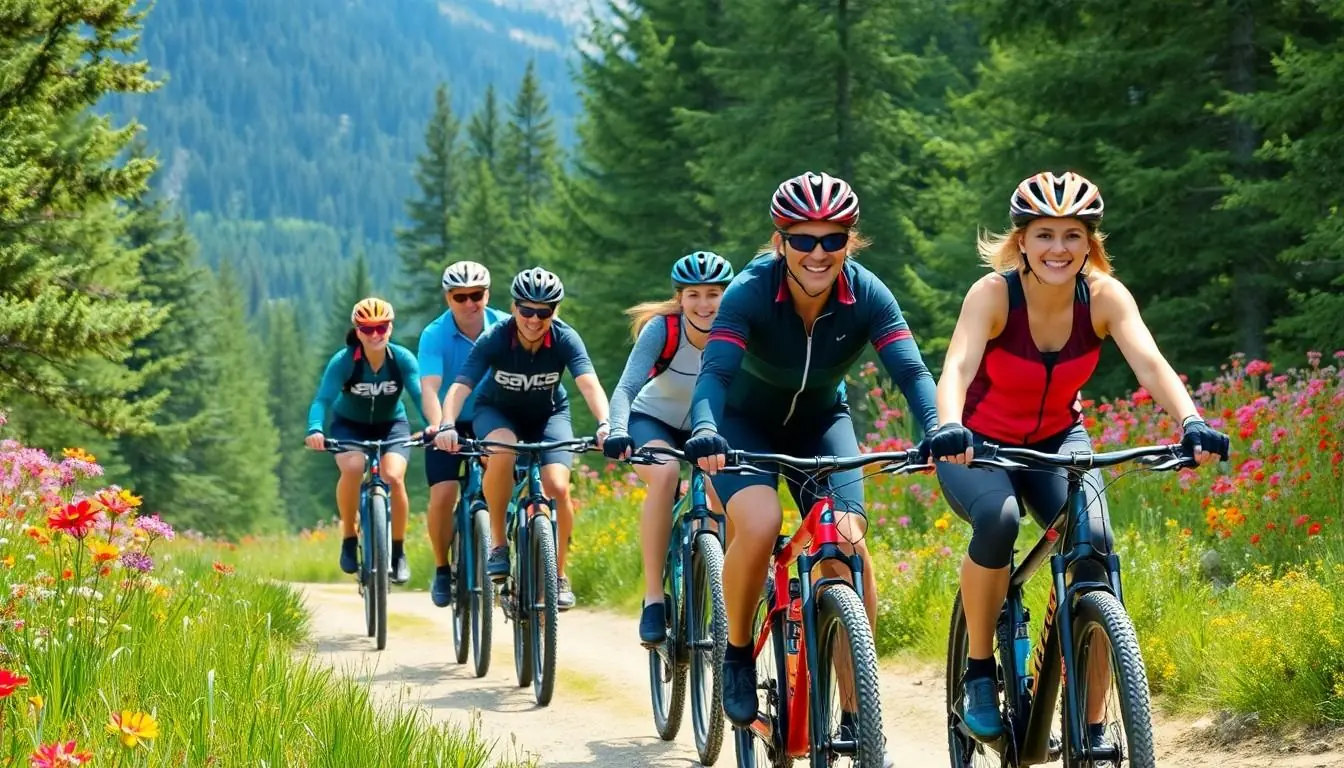Table of Contents
ToggleImagine this: the sun’s shining, the breeze is just right, and the only thing standing between you and adventure is a trusty bike. Trailhead cycling offers a thrilling escape from the daily grind, inviting riders to explore nature’s hidden gems while getting a workout that feels less like a chore and more like a joyride.
What Is Trailhead Cycling?
Trailhead cycling combines mountain biking and outdoor exploration. This activity occurs at trailheads, where cyclists begin their journey on predefined paths. Trailheads serve as entry points to diverse trails, ranging from easy to challenging. Cyclists often enjoy this experience for the thrill of navigating natural landscapes.
Various types of terrain characterize trailhead cycling. Some trails feature rocky paths, steep inclines, or smooth dirt roads. Cyclists encounter unique wildlife and stunning views along their routes. A sense of adventure often motivates individuals to participate, blending fitness and enjoyment.
Equipment plays a crucial role in the trailhead cycling experience. Mountain bikes are essential for handling rugged terrains. Helmets, gloves, and appropriate footwear enhance safety and performance. Riders should also carry essentials like water, snacks, and a map or GPS device for navigation.
Trailhead cycling fosters a sense of community. Many enthusiasts participate in group rides or local events. These gatherings allow cyclists to share experiences and tips while enjoying the trails together. Structured trails help maintain safety and accessibility for participants of all skill levels.
Overall, trailhead cycling offers a dynamic way to explore the great outdoors. It provides a platform for exercise, adventure, and social interaction. Newcomers and seasoned riders alike find this activity an appealing escape from daily routines.
Benefits of Trailhead Cycling

Trailhead cycling offers numerous benefits that enhance both physical and mental well-being. Engaging with nature while cycling boosts overall health and promotes a strong sense of community.
Physical Health Advantages
Trailhead cycling improves cardiovascular fitness, leading to a stronger heart and increased lung capacity. It promotes muscle strength, especially in the legs, core, and back, due to varying terrains. Regular cycling supports weight management by burning calories; an hour of moderate cycling can burn around 400-600 calories. Additionally, balance and coordination improve through navigating trails, which helps prevent falls or injuries in daily activities. Overall, the combination of endurance and strength training provides an effective workout.
Mental Health Benefits
Trailhead cycling significantly reduces stress levels by allowing cyclists to immerse themselves in nature. Exposure to outdoor environments increases serotonin production, enhancing mood and combatting anxiety. Riding with peers fosters social connections, which decreases feelings of isolation. Adventure and exploration trigger joy and satisfaction, enriching the overall cycling experience. Furthermore, the rhythmic nature of pedaling promotes mindfulness, allowing cyclists to focus on the present moment. Engaging in this activity consistently leads to better mental resilience and emotional health.
Choosing the Right Trailhead
Selecting an appropriate trailhead enhances the trailhead cycling experience. Cyclists must evaluate various factors to ensure an enjoyable ride.
Factors to Consider
Terrain difficulty influences trailhead selection. Beginners may opt for easier, well-marked trails, while advanced riders might seek rugged paths. Accessibility matters, too; proximity to home or local amenities adds convenience. Weather conditions significantly affect trail conditions; check forecasts before heading out. Lastly, understanding elevation changes allows cyclists to prepare for climbs and descents.
Popular Locations
Many popular locations attract trailhead cycling enthusiasts. The Tahoe Rim Trail offers scenic views and diverse terrain, suitable for various skill levels. Moab, Utah, features iconic trails like Porcupine Rim, well-known for its challenging descents. In Colorado, the Crested Butte Mountain Bike Association provides numerous trails, catering to both novices and experts. Each location promises unique experiences and stunning landscapes, inviting all cyclists to explore.
Essential Gear for Trailhead Cycling
Essential gear enhances the trailhead cycling experience. Appropriate equipment ensures safety and performance during rides.
Biking Equipment
Mountain bikes serve as the cornerstone of trailhead cycling. Bikes designed for rugged terrains withstand various conditions, including rocky paths and steep climbs. Cyclists should prioritize lightweight frames that balance durability and agility. Tires with good traction provide grip on diverse surfaces. Gears and suspension systems designed for off-road cycling allow for smoother navigation across challenging landscapes. Accessories like bike pumps and repair kits also prove useful in remote areas, minimizing disruptions during rides.
Safety Gear
Safety gear remains critical for trailhead cyclists. Helmets protect against head injuries and should fit snugly. Gloves offer grip and reduce fatigue during long rides. Padding on shorts adds comfort and helps prevent chafing. Eye protection shields from debris and sunlight. Bright-colored clothing enhances visibility, especially on busy trails. First aid kits equipped with basic supplies ensure readiness for minor injuries. Cyclists may also consider knee and elbow pads for extra protection on rugged terrain. Prioritizing safety gear promotes confidence and enjoyment while exploring the outdoors.
Tips for an Enjoyable Experience
Planning routes enhances the enjoyment of trailhead cycling. Cyclists should familiarize themselves with trail maps and local conditions before heading out. Use GPS apps or printed maps for navigation, noting landmarks and rest stops along the way. Selecting trails that match skill levels ensures safety and satisfaction. Mixing easier paths with challenging ones can provide a balanced experience, appealing to varying abilities within a group.
Trail etiquette promotes respect and consideration among cyclists and other trail users. Yielding the right of way to pedestrians and uphill riders maintains harmony on shared trails. Cyclists must communicate clearly, using verbal signals or hand gestures when passing others. Staying on designated paths preserves the environment and prevents trail damage. Cleanliness is crucial; packing out what is brought in helps keep trails pristine for future adventurers.
Trailhead cycling stands out as a thrilling way to connect with nature while achieving fitness goals. It combines adventure with community, making it a rewarding pursuit for riders of all levels. The right gear and careful planning enhance the experience, ensuring safety and enjoyment on every ride.
By embracing trail etiquette and respecting the environment cyclists can contribute to the preservation of these beautiful landscapes. Whether navigating challenging terrains or enjoying scenic routes, trailhead cycling offers an enriching escape that promotes both physical health and mental well-being. It’s an adventure waiting to be explored.




